Document Outline
- FEATURES
- APPLICATIONS
- GENERAL DESCRIPTION
- FUNCTIONAL BLOCK DIAGRAM
- PRODUCT HIGHLIGHTS
- TABLE OF CONTENTS
- ˛ˇ
- ˛ˇ
- ˛ˇ
- ˛ˇ
- ˛ˇ
- ˛ˇ
- ˛ˇ
- ˛ˇ
- ˛ˇ
- ˛ˇ
- ˛ˇ
- ˛ˇ
- ˛ˇ
- ˛ˇ
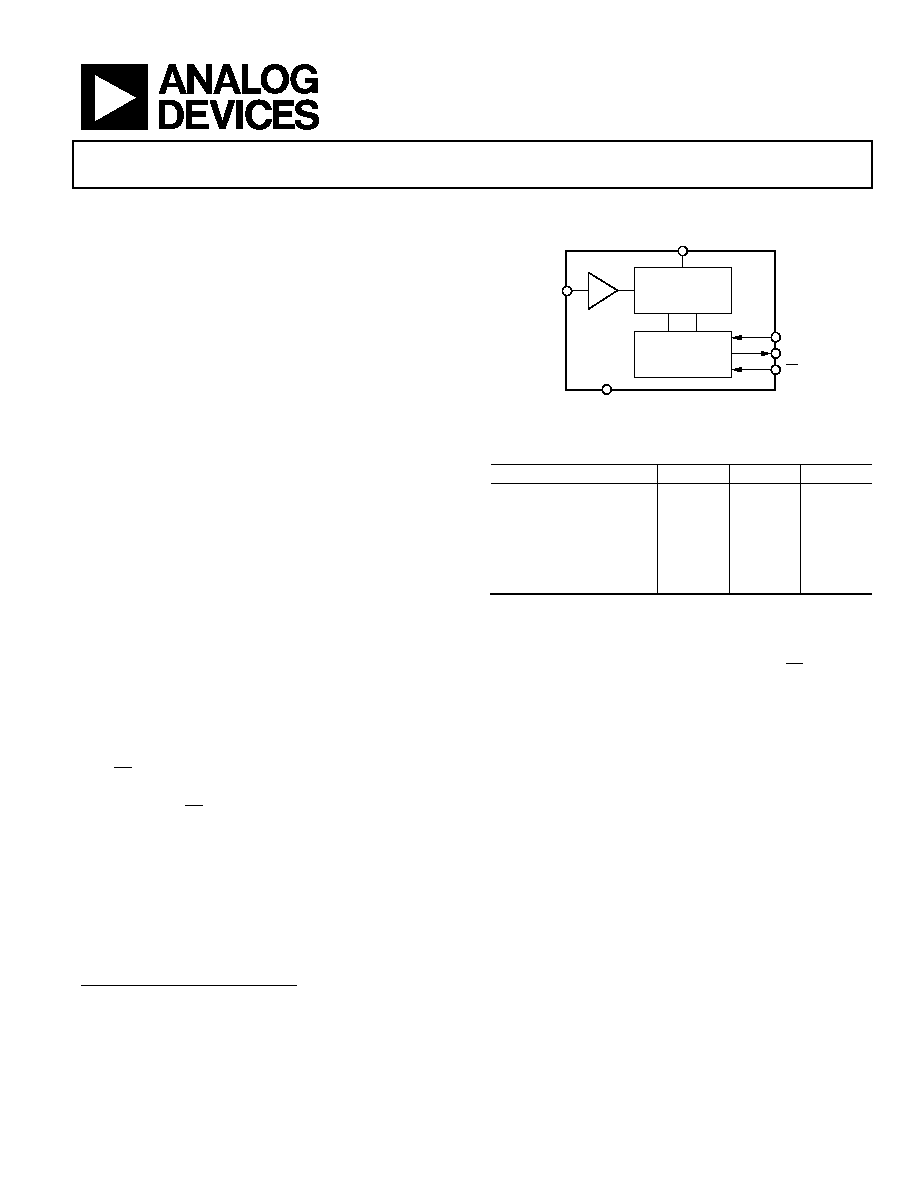
3 mW, 100 kSPS,
14-Bit ADC in 6-Lead SOT-23
AD7940
Rev. 0
Information furnished by Analog Devices is believed to be accurate and reliable.
However, no responsibility is assumed by Analog Devices for its use, nor for any
infringements of patents or other rights of third parties that may result from its use.
Specifications subject to change without notice. No license is granted by implication
or otherwise under any patent or patent rights of Analog Devices. Trademarks and
registered trademarks are the property of their respective owners.
One Technology Way, P.O. Box 9106, Norwood, MA 02062-9106, U.S.A.
Tel: 781.329.4700
www.analog.com
Fax: 781.326.8703
© 2004 Analog Devices, Inc. All rights reserved.
FEATURES
Fast throughput rate: 100 kSPS
Specified for V
DD
of 2.5 V to 5.5 V
Low power
4 mW typ at 100 kSPS with 3 V supplies
17 mW typ at 100 kSPS with 5 V supplies
Wide input bandwidth:
81 dB SINAD at 10 kHz input frequency
Flexible power/serial clock speed management
No pipeline delays
High speed serial interface
SPIÆ/QSPITM/MICROWIRETM/DSP compatible
Standby mode: 0.5 µA max
6-Lead SOT-23 and 8-Lead MSOP packages
APPLICATIONS
Battery-powered systems
Personal digital assistants
Medical instruments
Mobile communications
Instrumentation and control systems
Remote data acquisition systems
FUNCTIONAL BLOCK DIAGRAM
03305-0-001
V
IN
V
DD
GND
AD7940
SCLK
SDATA
CS
T/H
14-BIT SUCCESSIVE
APPROXIMATION
ADC
CONTROL
LOGIC
Figure 1.
Table 1. 16-Bit and 14-Bit ADC (MSOP and SOT-23)
Type
100 kSPS
250 kSPS
500 kSPS
16-Bit True Differential
AD7684
AD7687
AD7688
16-Bit Pseudo Differential
AD7683
AD7685
AD7686
16-Bit Unipolar
AD7680
14-Bit True Differential
AD7944
AD7947
14-Bit Pseudo Differential
AD7942
AD7946
14-Bit Unipolar
AD7940
GENERAL DESCRIPTION
The AD7940
1
is a 14-bit, fast, low power, successive approxima-
tion ADC. The part operates from a single 2.50 V to 5.5 V power
supply and features throughput rates up to 100 kSPS. The part
contains a low noise, wide bandwidth track-and-hold amplifier
that can handle input frequencies in excess of 7 MHz.
The conversion process and data acquisition are controlled
using CS and the serial clock, allowing the devices to interface
with microprocessors or DSPs. The input signal is sampled on
the falling edge of CS and the conversion is also initiated at this
point. There are no pipelined delays associated with the part.
The AD7940 uses advanced design techniques to achieve very
low power dissipation at fast throughput rates. The reference for
the part is taken internally from V
DD
, which allows the widest
dynamic input range to the ADC. Thus, the analog input range
for this part is 0 V to V
DD
. The conversion rate is determined by
the SCLK frequency.
1
Protected by U.S. Patent No. 6,681,332.
This part features a standard successive approximation ADC
with accurate control of the sampling instant via a CS input and
once off conversion control.
PRODUCT HIGHLIGHTS
1.
First 14-bit ADC in a SOT-23 package.
2.
High throughput with low power consumption.
3.
Flexible power/serial clock speed management. The con-
version rate is determined by the serial clock, allowing the
conversion time to be reduced through the serial clock
speed increase. This allows the average power consumption
to be reduced when a power-down mode is used while not
converting. The part also features a shutdown mode to
maximize power efficiency at lower throughput rates.
Power consumption is 0.5 µA max when in shutdown.
4.
Reference derived from the power supply.
5.
No pipeline delay.

AD7940
Rev. 0 | Page 2 of 20
TABLE OF CONTENTS
Specifications..................................................................................... 3
Timing Specifications....................................................................... 5
Absolute Maximum Ratings............................................................ 6
ESD Caution.................................................................................. 6
Pin Configurations and Function Descriptions ........................... 7
Terminology ...................................................................................... 8
Typical Performance Characteristics ............................................. 9
Circuit Information ........................................................................ 11
Converter Operation.................................................................. 11
Analog Input ............................................................................... 11
ADC Transfer Function ................................................................. 12
Typical Connection Diagram ................................................... 12
Modes of Operation ....................................................................... 13
Normal Mode.............................................................................. 13
Power-Down Mode .................................................................... 14
Power vs. Throughput Rate ........................................................... 15
Serial Interface ................................................................................ 16
Microprocessor Interfacing........................................................... 17
AD7940 to TMS320C541 .......................................................... 17
AD7940 to ADSP-218x.............................................................. 17
AD7940 to DSP563xx ................................................................ 18
Application Hints ........................................................................... 19
Grounding and Layout .............................................................. 19
Evaluating the AD7940 Performance ...................................... 19
Outline Dimensions ....................................................................... 20
Ordering Guide .......................................................................... 20
REVISION HISTORY
6/04--Revision 0: Initial Version
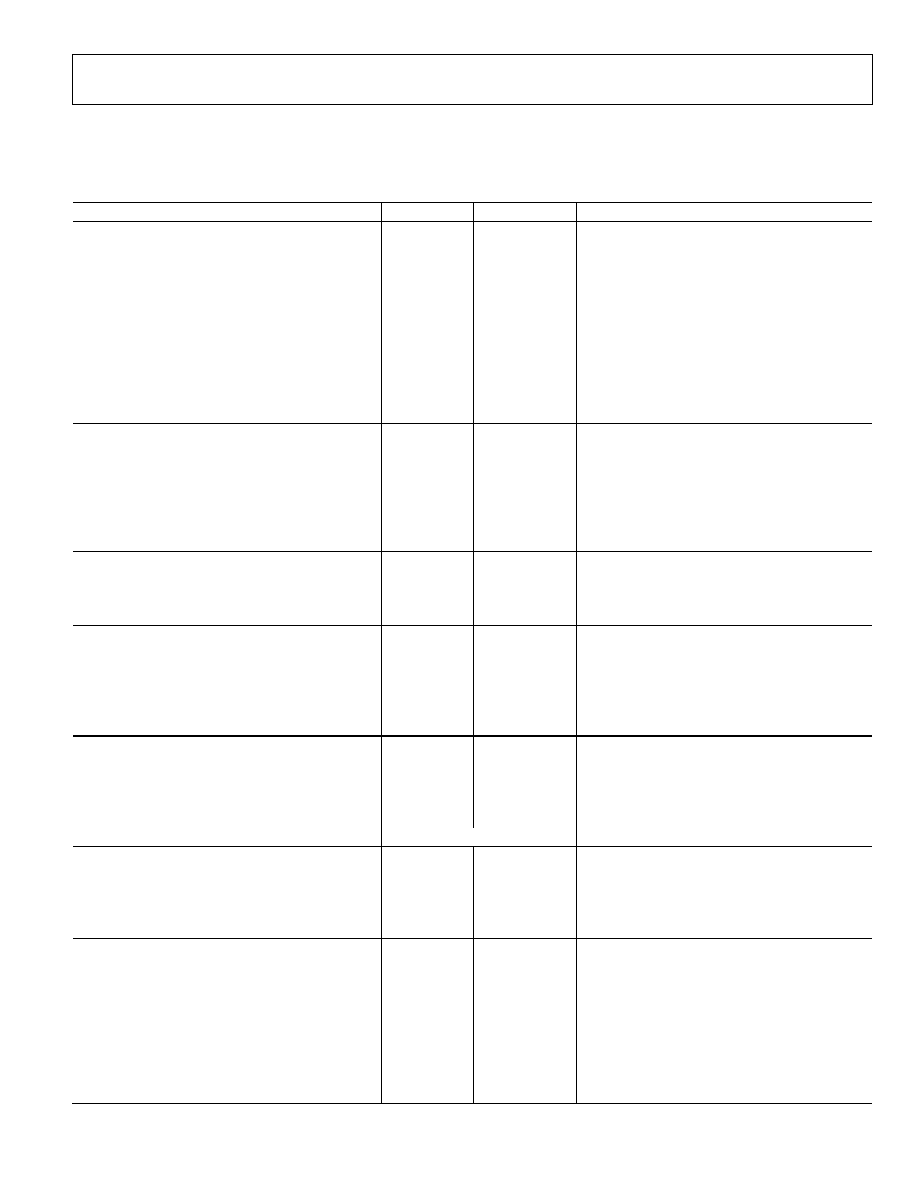
AD7940
Rev. 0 | Page 3 of 20
SPECIFICATIONS
1
V
DD
= 2.50 V to 5.5 V, f
SCLK
= 2.5 MHz, f
SAMPLE
= 100 kSPS, unless otherwise noted; T
A
= T
MIN
to T
MAX
, unless otherwise noted.
Table 2.
Parameter B
Version
1
Unit
Test Conditions/Comments
DYNAMIC PERFORMANCE
f
IN
= 10 kHz sine wave
Signal-to-Noise + Distortion (SINAD)
2
81 dB
min
Total Harmonic Distortion (THD)
2
-98
dB typ
Peak Harmonic or Spurious Noise (SFDR)
2
-95
dB typ
Intermodulation Distortion (IMD)
2
Second-Order Terms
-94
dB typ
Third-Order Terms
-100
dB typ
Aperture Delay
20
ns max
Aperture Jitter
30
ps typ
Full Power Bandwidth
7
MHz typ
@ -3 dB
2
MHz typ
@ -0.1 dB
DC ACCURACY
Resolution
14
Bits min
V
DD
= 2.5 V to 4.096 V
13
Bits
min
V
DD
> 4.096 V
Integral Nonlinearity
2
±1
LSB max
V
DD
= 2.5 V to 4.096 V
±2
LSB max
V
DD
> 4.096 V
Offset Error
2
±6
LSB max
Gain Error
2
±8
LSB max
ANALOG INPUT
Input Voltage Ranges
0 to V
DD
V
DC Leakage Current
±0.3
µA max
Input Capacitance
30
pF typ
LOGIC INPUTS
Input High Voltage, V
INH
2.4
V min
Input Low Voltage, V
INL
0.4
V max
V
DD
= 3 V
0.8
V
max
V
DD
= 5 V
Input Current, I
IN
±0.3
µA max
Typically 10 nA, V
IN
= 0 V or V
DD
Input Capacitance, C
IN
2, 3
10
pF max
LOGIC OUTPUTS
Output High Voltage, V
OH
V
DD
≠ 0.2
V min
I
SOURCE
= 200 µA; V
DD
= 2.50 V to 5.25 V
Output Low Voltage, V
OL
0.4
V max
I
SINK
= 200 µA
Floating-State Leakage Current
±0.3
µA max
Floating-State Output Capacitance
2, 3
10
pF max
Output Coding
Straight (Natural) Binary
CONVERSION RATE
Conversion Time
8
µs max
16 SCLK cycles
Track-and-Hold Acquisition Time
500
ns max
Full-scale step input
400
ns max
Sine wave input 10 kHz
Throughput Rate
100
kSPS max
See the Serial Interface section
POWER REQUIREMENTS
V
DD
2.50/5.5
V min/V max
I
DD
Digital I/P
S
= 0 V or V
DD
Normal Mode (Static)
5.2
mA max
V
DD
= 5.5 V; SCLK on or off
2
mA max
V
DD
= 3.6 V; SCLK on or off
Normal Mode (Operational)
4.8
mA max
V
DD
= 5.5 V; f
SAMPLE
= 100 kSPS; 3.3 mA typ
1.9
mA
max
V
DD
= 3.6 V; f
SAMPLE
= 100 kSPS; 1.29 mA typ
Full Power-Down Mode
0.5
µA max
SCLK on or off. V
DD
= 5.5 V
0.3
µA max
SCLK on or off. V
DD
= 3.6 V

AD7940
Rev. 0 | Page 4 of 20
Parameter B
Version
1
Unit
Test Conditions/Comments
Power Dissipation
4
V
DD
= 5.5 V
Normal Mode (Operational)
26.4
mW max
V
DD
= 5.5 V; f
SAMPLE
= 100 kSPS
6.84
mW max
V
DD
= 3.6 V; f
SAMPLE
= 100 kSPS
Full Power-Down
2.5
µW max
V
DD
= 5.5 V
1.08
µW max
V
DD
= 3.6 V
1
Temperature range for B Version is ≠40∞C to +85∞C.
2
See the
section.
Terminology
3
Sample tested at initial release to ensure compliance.
4
See the
section.
Power vs. Throughput Rate
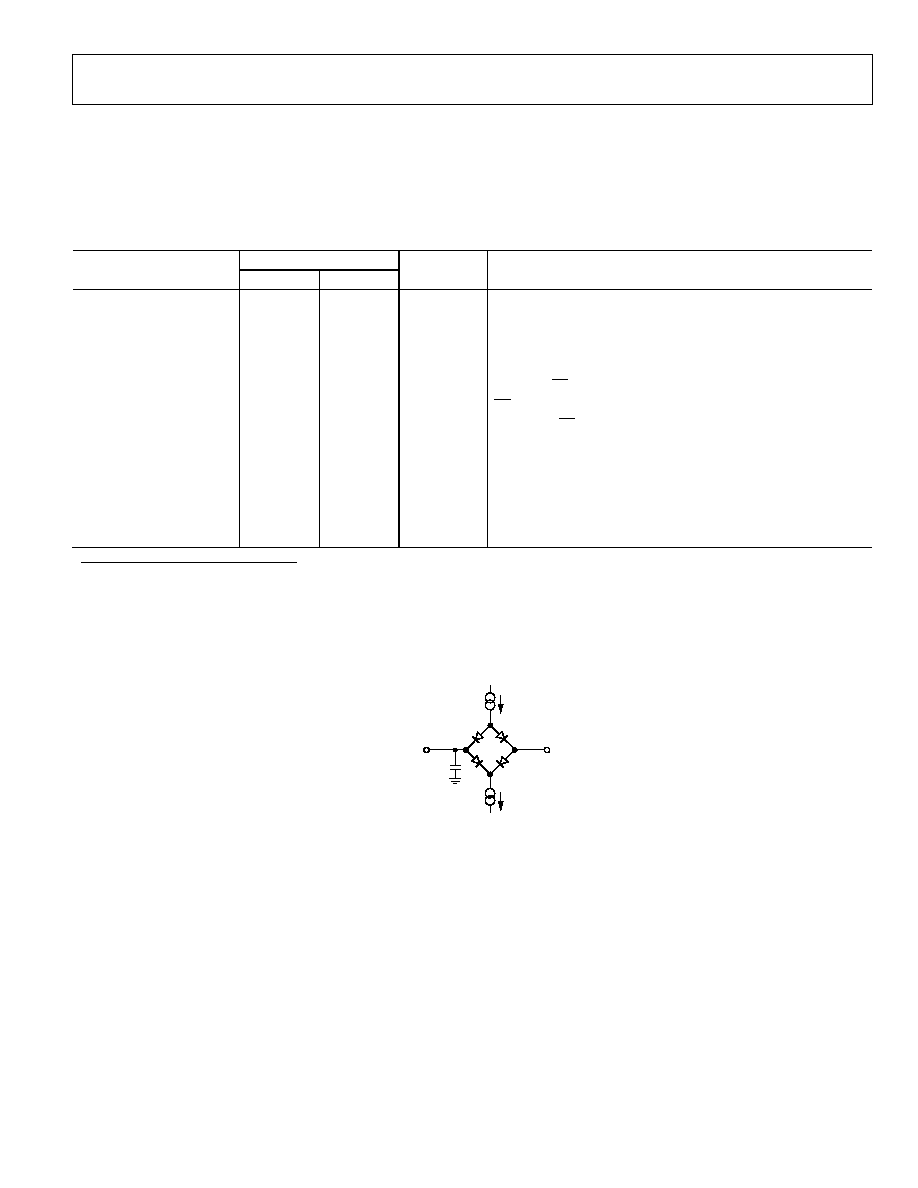
AD7940
Rev. 0 | Page 5 of 20
TIMING SPECIFICATIONS
Sample tested at initial release to ensure compliance. All input signals are specified with tr = tf = 5 ns (10% to 90% of V
DD
) and timed from
a voltage level of 1.6 V.
V
DD
= 2.50 V to 5.5 V; T
A
= T
MIN
to T
MAX
, unless otherwise noted.
Table 3.
Limit at T
MIN
, T
MAX
Parameter
3 V
5 V
Unit
Description
f
SCLK
1
250
250
kHz min
2.5
2.5
MHz max
t
CONVERT
16 ◊ t
SCLK
16 ◊ t
SCLK
min
t
QUIET
50
50
ns min
Minimum quiet time required between bus relinquish and start of
next conversion
t
1
10
10
ns min
Minimum CS pulse width
t
2
10
10
ns min
CS to SCLK setup time
t
3
2
48
35
ns max
Delay from CS until SDATA three-state disabled
t
4
2
120
80
ns max
Data access time after SCLK falling edge
t
5
0.4 t
SCLK
0.4 t
SCLK
ns min
SCLK low pulse width
t
6
0.4 t
SCLK
0.4 t
SCLK
ns min
SCLK high pulse width
t
7
10
10
ns min
SCLK to data valid hold time
t
8
3
45
35
ns max
SCLK falling edge to SDATA high impedance
t
POWER-UP
4
1
1
µs typ
Power up time from full power-down
1
Mark/space ratio for the SCLK input is 40/60 to 60/40.
2
Measured with the load circuit of
and defined as the time required for the output to cross 0.8 V or 2.0 V.
Figure 2
Figure 2.
3
t
8
is derived form the measured time taken by the data outputs to change 0.5 V when loaded with the circuit of
The measured number is then extrapolated
back to remove the effects of charging or discharging the 50 pF capacitor. This means that the time, t
8
, quoted in the timing characteristics is the true bus relinquish
time of the part and is independent of the bus loading.
4
See the
section.
Power vs. Throughput Rate
03305-0-002
200
µ
A
I
OL
200
µ
A
I
OH
1.6V
TO OUTPUT
PIN
C
L
50pF
Figure 2. Load Circuit for Digital Output Timing Specification
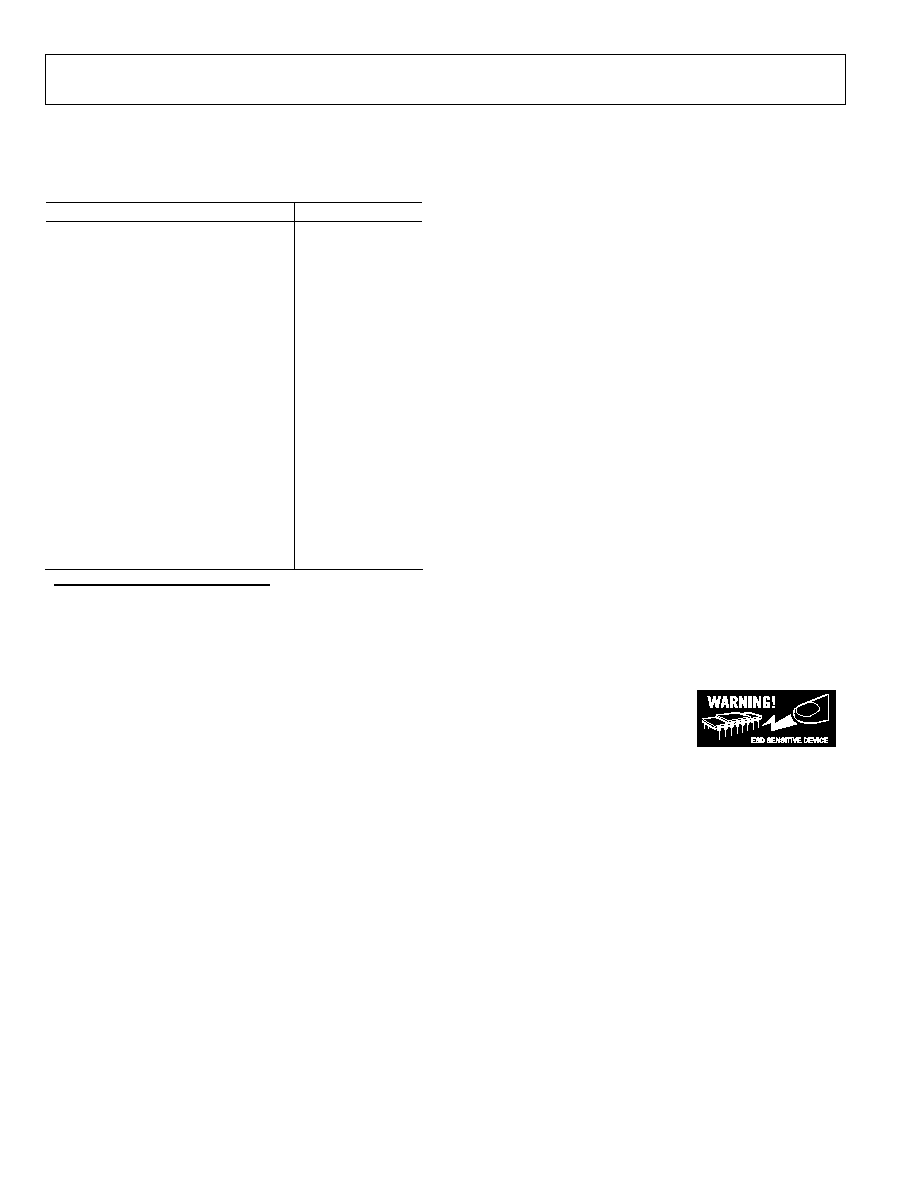
AD7940
Rev. 0 | Page 6 of 20
ABSOLUTE MAXIMUM RATINGS
T
A
= 25∞C, unless otherwise noted.
Table 4.
Parameter Rating
V
DD
to GND
-0.3 V to +7 V
Analog Input Voltage to GND
-0.3 V to V
DD
+ 0.3 V
Digital Input Voltage to GND
-0.3 V to +7 V
Digital Output Voltage to GND
-0.3 V to V
DD
+ 0.3 V
Input Current to Any Pin Except Supplies
1
±10 mA
Operating Temperature Range
Commercial (B Version)
-40∞C to +85∞C
Storage Temperature Range
-65∞C to +150∞C
Junction Temperature
150∞C
SOT-23 Package, Power Dissipation
450 mW
JA
Thermal Impedance
229.6∞C/W
JC
Thermal Impedance
91.99∞C/W
MSOP Package, Power Dissipation
450 mW
JA
Thermal Impedance
205.9∞C/W
JC
Thermal Impedance
43.74∞C/W
Lead Temperature, Soldering
Vapor Phase (60 secs)
215∞C
Infared (15 secs)
220∞C
ESD
4 kV
1
Transient currents of up to 100 mA will not cause SCR latch-up.
Stresses above those listed under Absolute Maximum Ratings
may cause permanent damage to the device. This is a stress rat-
ing only; functional operation of the device at these or any
other conditions above those listed in the operational sections
of this specification is not implied. Exposure to absolute maxi-
mum rating conditions for extended periods may affect device
reliability.
ESD CAUTION
ESD (electrostatic discharge) sensitive device. Electrostatic charges as high as 4000 V readily accumulate on the
human body and test equipment and can discharge without detection. Although this product features
proprietary ESD protection circuitry, permanent damage may occur on devices subjected to high energy
electrostatic discharges. Therefore, proper ESD precautions are recommended to avoid performance
degradation or loss of functionality.

AD7940
Rev. 0 | Page 7 of 20
PIN CONFIGURATIONS AND FUNCTION DESCRIPTIONS
03305-0-023
CS
SDATA
SCLK
6
5
4
V
DD
1
GND
2
V
IN
3
AD7940
TOP VIEW
(Not to Scale)
SOT-23
Figure 3. SOT-23 Pin Configuration
03305-0-003
NC = NO CONNECT
AD7490
MSOP
TOP VIEW
(Not to Scale)
V
DD
1
GND
2
GND
3
V
IN
4
CS
SDATA
NC
SCLK
8
7
6
5
Figure 4. MSOP Pin Configuration
Table 5. Pin Function Descriptions
Pin No.
SOT-23
Pin No.
MSOP Mnemonic
Function
1 1 V
DD
Power Supply Input. The V
DD
range for the AD7940 is from 2.5 V to 5.5 V.
2
2, 3
GND
Analog Ground. Ground reference point for all circuitry on the AD7940. All analog input signals should
be referred to this GND voltage.
3 4 V
IN
Analog Input. Single-ended analog input channel. The input range is 0 V to V
DD
.
4 5 SCLK
Serial Clock. Logic input. SCLK provides the serial clock for accessing data from this part. This clock
input is also used as the clock source for the AD7940's conversion process.
5 7 SDATA
Data Out. Logic output. The conversion result from the AD7940 is provided on this output as a serial
data stream. The bits are clocked out on the falling edge of the SCLK input. The data stream from the
AD7940 consists of two leading zeros followed by 14 bits of conversion data that are provided MSB
first. This will be followed by four trailing zeroes if CS is held low for a total of 24 SCLK cycles. See the
Serial Interface section.
6 8 CS
Chip Select. Active low logic input. This input provides the dual function of initiating conversions on
the AD7940 and framing the serial data transfer.
N/A
6
NC
No Connect. This pin should be left unconnected.

AD7940
Rev. 0 | Page 8 of 20
TERMINOLOGY
Integral Nonlinearity
This is the maximum deviation from a straight line passing
through the endpoints of the ADC transfer function. The end-
points of the transfer function are zero scale, a point 1/2 LSB
below the first code transition, and full scale, a point 1/2 LSB
above the last code transition.
Differential Nonlinearity
This is the difference between the measured and the ideal 1 LSB
change between any two adjacent codes in the ADC.
Offset Error
This is the deviation of the first code transition (00 . . . 000) to
(00 . . . 001) from the ideal, i.e., AGND + 1 LSB.
Gain Error
This is the deviation of the last code transition (111 . . . 110) to
(111 . . . 111) from the ideal (i.e., V
REF
- 1 LSB) after the offset
error has been adjusted out.
Track-and-Hold Acquisition Time
The track-and-hold amplifier returns to track mode at the end
of conversion. The track-and-hold acquisition time is the time
required for the output of the track-and-hold amplifier to reach
its final value, within ±1 LSB, after the end of the conversion.
See the Serial Interface section for more details.
Signal-to-(Noise + Distortion) Ratio
This is the measured ratio of signal-to-(noise + distortion) at
the output of the ADC. The signal is the rms amplitude of the
fundamental. Noise is the sum of all nonfundamental signals up
to half the sampling frequency (f
S
/2, excluding dc). The ratio
depends on the number of quantization levels in the digitization
process; the more levels, the smaller the quantization noise. The
theoretical signal-to-(noise + distortion) ratio for an ideal N-bit
converter with a sine wave input is given by
Signal-to-(Noise + Distortion) = (6.02 N + 1.76) dB
Thus, for a 14-bit converter, this is 86.04 dB.
Total Harmonic Distortion (THD)
THD is the ratio of the rms sum of harmonics to the funda-
mental. For the AD7940, it is defined as
1
2
6
2
5
2
4
2
3
2
2
V
V
V
V
V
V
log
20
(dB)
+
+
+
+
=
THD
where V
1
is the rms amplitude of the fundamental and V
2
, V
3
,
V
4
, V
5
, and V
6
are the rms amplitudes of the second through the
sixth harmonics.
Peak Harmonic or Spurious Noise
Peak harmonic or spurious noise is defined as the ratio of the
rms value of the next largest component in the ADC output
spectrum (up to f
S
/2, excluding dc) to the rms value of the fun-
damental. Normally, the value of this specification is deter-
mined by the largest harmonic in the spectrum, but for ADCs
where the harmonics are buried in the noise floor, it will be a
noise peak.
Intermodulation Distortion
With inputs consisting of sine waves at two frequencies, fa and fb,
any active device with nonlinearities will create distortion prod-
ucts at sum and difference frequencies of mfa ± nfb where m, n =
0, 1, 2, 3. Intermodulation distortion terms are those for which
neither m nor n are equal to zero. For example, the second-order
terms include (fa + fb) and (fa - fb), while the third-order terms
include (2fa + fb), (2fa - fb), (fa + 2fb), and (fa -2fb).
The AD7940 is tested using the CCIF standard where two input
frequencies near the top end of the input bandwidth are used.
In this case, the second-order terms are usually distanced in
frequency from the original sine waves, while the third-order
terms are usually at a frequency close to the input frequencies.
As a result, the second- and third-order terms are specified
separately. The calculation of the intermodulation distortion is
as per the THD specification where it is the ratio of the rms
sum of the individual distortion products to the rms amplitude
of the sum of the fundamentals expressed in dBs.

AD7940
Rev. 0 | Page 9 of 20
TYPICAL PERFORMANCE CHARACTERISTICS
Figure 5 shows a typical FFT plot for the AD7940 at 100 kSPS
sample rate and 10 kHz input frequency. Figure 6 shows the
signal-to-(noise + distortion) ratio performance versus the
input frequency for various supply voltages while sampling at
100 kSPS with an SCLK of 2.5 MHz.
Figure 7 shows a graph of the total harmonic distortion versus
the analog input frequency for various supply voltages, while
Figure 8 shows a graph of the total harmonic distortion versus
the analog input frequency for various source impedances (see
the Analog Input section). Figure 9 and Figure 10 show the
typical INL and DNL plots for the AD7940.
03305-0-019
(dB)
≠140
≠120
≠100
≠80
≠60
≠40
≠20
≠160
0
10k
20k
30k
40k
FREQUENCY (kHz)
50k
0
V
DD
= 4.75V
F
SAMPLE
= 100kSPS
F
IN
= 10kHz
SNR = 84.48dB
SINAD = 84.35dB
THD = ≠98.97dB
SFDR = ≠100.84dB
Figure 5. AD7940 Dynamic Performance at 100 kSPS
03305-0-020
S
I
NAD (dB)
80
85
75
10
INPUT FREQUENCY (kHz)
100
90
F
SAMPLE
= 100kSPS
T
A
= 25
∞
C
V
DD
= 5.25V
V
DD
= 4.75V
V
DD
= 2.5V
V
DD
= 4.3V
V
DD
= 3.6V
V
DD
= 3V
V
DD
= 2.7V
Figure 6. AD7940 SINAD vs. Analog Input Frequency
for Various Supply Voltages at 100 kSPS
03305-0-021
THD (dB)
90
100
80
10
INPUT FREQUENCY (kHz)
100
110
85
95
105
F
SAMPLE
= 100kSPS
T
A
= 25
∞
C
V
DD
= 3V
V
DD
= 2.7V
V
DD
= 4.3V
V
DD
= 2.5V
V
DD
= 5.25V
V
DD
= 4.75V
V
DD
= 3.6V
Figure 7. AD7940 THD vs. Analog Input Frequency
for Various Supply Voltages at 100 kSPS
03305-0-022
THD (dB)
90
100
70
75
10
INPUT FREQUENCY (kHz)
100
110
85
80
95
105
F
SAMPLE
= 100kSPS
T
A
= 25
∞
C
V
DD
= 4.75V
R
IN
= 10
R
IN
= 50
R
IN
= 100
R
IN
= 1000
Figure 8. AD7940 THD vs. Analog Input Frequency
for Various Source Impedances
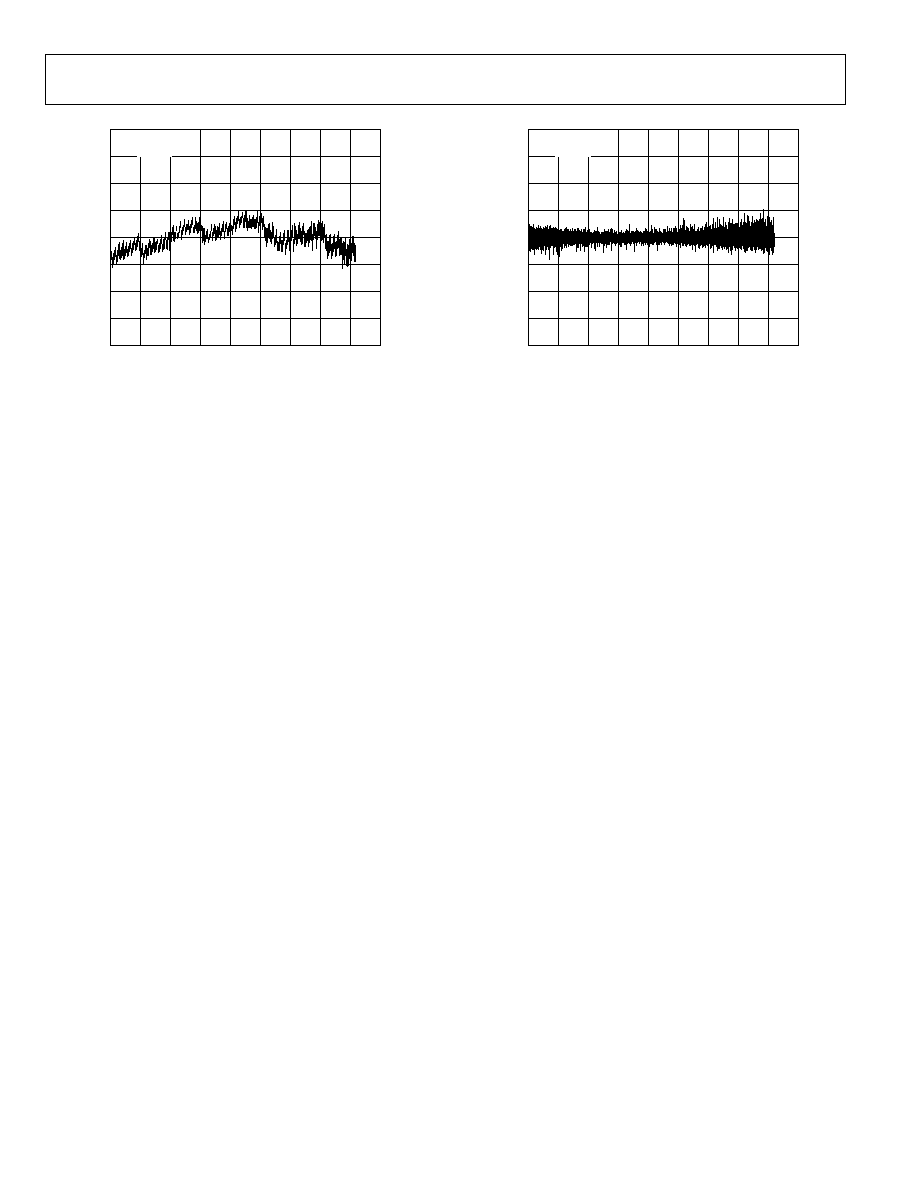
AD7940
Rev. 0 | Page 10 of 20
03305-0-018
INL E
RROR (LS
B
)
≠0.4
≠0.2
0
0.2
0.4
0.6
0.8
≠0.6
0
2000
4000
6000 8000 10000 12000 14000 16000
CODE
18000
1.0
V
DD
= 3.00V
TEMP = 25
∞
C
Figure 9. AD7940 Typical INL
03305-0-017
DNL E
RROR (LS
B
)
≠0.6
≠0.4
≠0.2
0
0.2
0.4
0.6
≠0.8
0
2000
4000
6000 8000 10000 12000 14000 16000
CODE
18000
0.8
V
DD
= 3.00V
TEMP = 25
∞
C
Figure 10. AD7940 Typical DNL

AD7940
Rev. 0 | Page 11 of 20
CIRCUIT INFORMATION
The AD7940 is a fast, low power, 14-bit, single-supply ADC. The
part can be operated from a 2.50 V to 5.5 V supply. When operated
at either 5 V or 3 V supply, the AD7940 is capable of throughput
rates of 100 kSPS when provided with a 2.5 MHz clock.
The AD7940 provides the user with an on-chip track-and-hold
ADC and a serial interface housed in a tiny 6-lead SOT-23
package or in an 8-lead MSOP package, which offer the user
considerable space-saving advantages over alternative solutions.
The serial clock input accesses data from the part and also pro-
vides the clock source for the successive approximation ADC.
The analog input range for the AD7940 is 0 V to V
DD
. An external
reference is not required for the ADC nor is there a reference on-
chip. The reference for the AD7940 is derived from the power
supply and thus gives the widest dynamic input range.
The AD7940 also features a power-down option to save power
between conversions. The power-down feature is implemented
across the standard serial interface as described in the Modes of
Operation section.
CONVERTER OPERATION
The AD7940 is a 14-bit, successive approximation ADC based
around a capacitive DAC. The AD7940 can convert analog
input signals in the 0 V to V
DD
range. Figure 11 and Figure 12
show simplified schematics of the ADC. The ADC comprises of
control logic, SAR, and a capacitive DAC. Figure 11 shows the
ADC during its acquisition phase. SW2 is closed and SW1 is in
Position A. The comparator is held in a balanced condition and
the sampling capacitor acquires the signal on the selected V
IN
channel.
03305-0-004
CAPACITIVE
DAC
CONTROL
LOGIC
SAMPLING
CAPACITOR
COMPARATOR
ACQUISITION
PHASE
A
B
SW1
V
DD
/2
SW2
V
IN
Figure 11. ADC Acquisition Phase
When the ADC starts a conversion, SW2 will open and SW1
will move to Position B, causing the comparator to become
unbalanced (Figure 12). The control logic and the capacitive
DAC are used to add and subtract fixed amounts of charge
from the sampling capacitor to bring the comparator back into
a balanced condition. When the comparator is rebalanced, the
conversion is complete. The control logic generates the ADC
output code (see the ADC Transfer Function section).
03305-0-005
CAPACITIVE
DAC
CONTROL
LOGIC
SAMPLING
CAPACITOR
COMPARATOR
CONVERSION
PHASE
A
B
SW1
V
DD
/2
SW2
V
IN
Figure 12. ADC Conversion Phase
ANALOG INPUT
Figure 13 shows an equivalent circuit of the analog input struc-
ture of the AD7940. The two diodes, D1 and D2, provide ESD
protection for the analog inputs. Care must be taken to ensure
that the analog input signal never exceeds the supply rails by
more than 300 mV. This will cause these diodes to become
forward-biased and to start conducting current into the sub-
strate. The maximum current these diodes can conduct without
causing irreversible damage to the part is 10 mA. Capacitor C1
in Figure 13 is typically about 5 pF and primarily can be attrib-
uted to pin capacitance. Resistor R1 is a lumped component
made up of the on resistance of a switch (track-and-hold
switch). This resistor is typically about 25 . Capacitor C2 is the
ADC sampling capacitor and has a capacitance of 25 pF typi-
cally. For ac applications, removing high frequency components
from the analog input signal is recommended by use of an RC
low-pass filter on the relevant analog input pin. In applications
where harmonic distortion and signal-to-noise ratio are critical,
the analog input should be driven from a low impedance source.
Large source impedances will significantly affect the ac per-
formance of the ADC. This may necessitate the use of an input
buffer amplifier. The choice of the op amp will be a function of
the particular application. When no amplifier is used to drive
the analog input, the source impedance should be limited to low
values. The maximum source impedance will depend on the
amount of total harmonic distortion (THD) that can be toler-
ated. The THD will increase as the source impedance increases,
and performance will degrade (see Figure 8).
03305-0-006
R1
C2
30pF
CONVERSION PHASE - SWITCH OPEN
TRACK PHASE - SWITCH CLOSED
V
IN
V
DD
C1
4pF
D1
D2
Figure 13. Equivalent Analog Input Circuit
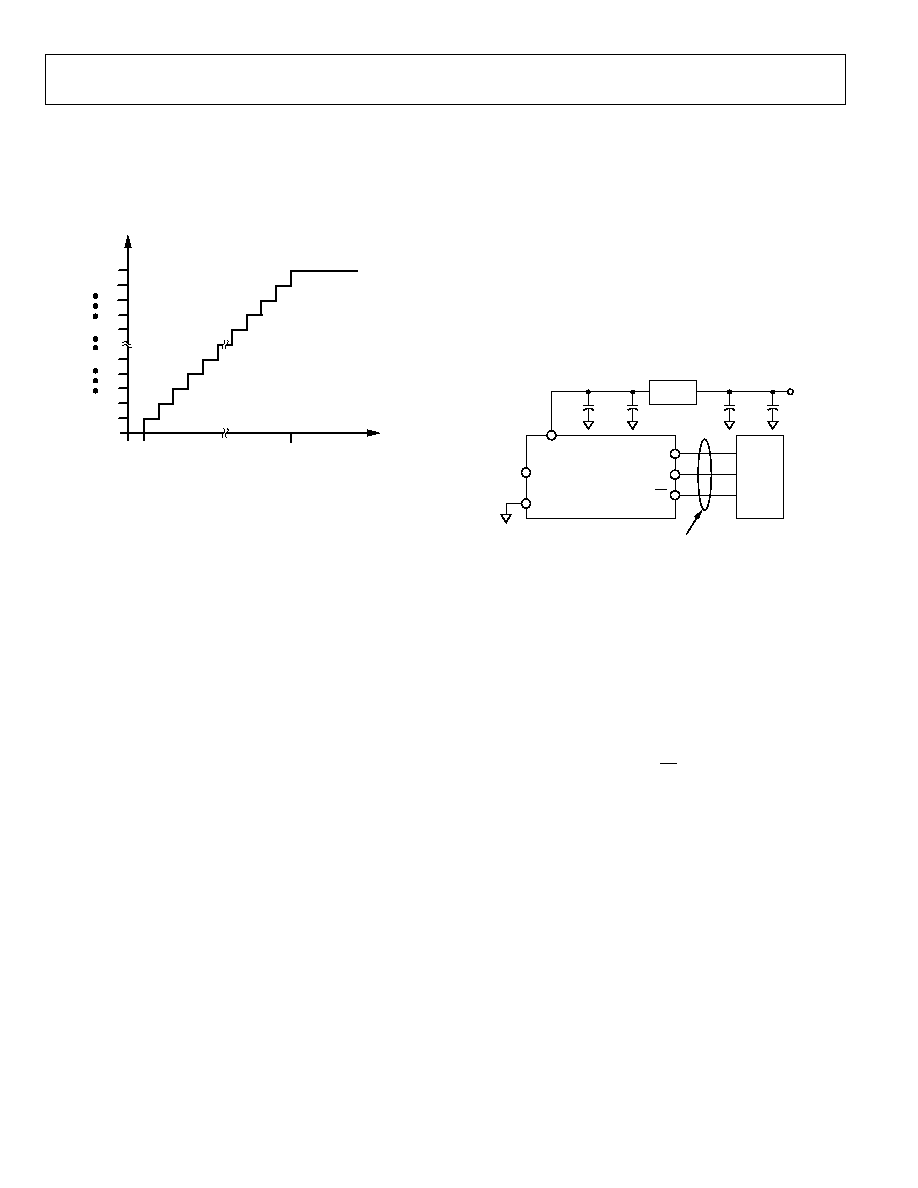
AD7940
Rev. 0 | Page 12 of 20
ADC TRANSFER FUNCTION
The output coding of the AD7940 is straight binary. The de-
signed code transitions occur at successive integer LSB values,
i.e., 1 LSB, 2 LSBs. The LSB size is V
DD
/16384. The ideal transfer
characteristic for the AD7940 is shown in Figure 14.
03305-0-007
000...000
111...111
1 LSB = V
DD
/16384
1 LSB
+V
DD
≠1 LSB
ANALOG INPUT
0V
000...001
000...010
111...110
111...000
011...111
Figure 14. AD7940 Transfer Characteristic
TYPICAL CONNECTION DIAGRAM
Figure 15 shows a typical connection diagram for the AD7940.
V
REF
is taken internally from V
DD
and as such should be well
decoupled. This provides an analog input range of 0 V to V
DD
.
The conversion result is output in a 16-bit word. This 16-bit
data stream consists of two leading zeros, followed by the 14 bits
of conversion data, MSB first. For applications where power
consumption is a concern, the power-down mode should be
used between conversions or bursts of several conversions to
improve power performance (see the Modes of Operation
section).
In fact, because the supply current required by the AD7940 is so
low, a precision reference can be used as the supply source to
the AD7940. For example, a REF19x voltage reference (REF195
for 5 V or REF193 for 3 V) or an AD780 can be used to supply
the required voltage to the ADC (see Figure 15). This configura-
tion is especially useful if the power supply available is quite
noisy, or if the system supply voltages are at some value other
than the required operating voltage of the AD7940, e.g., 15 V.
The REF19x or AD780 will output a steady voltage to the
AD7940. Recommended decoupling capacitors are a 100 nF low
ESR ceramic (Farnell 335-1816) and a 10 µF low ESR tantalum
(Farnell 197-130).
03305-
0-
008
AD7940
0V TO V
DD
INPUT
V
IN
SCLK
SDATA
SERIAL
INTERFACE
µ
C/
µ
P
CS
V
DD
GND
10
µ
F
TANT
0.1
µ
F
3V
10
µ
F
0.1
µ
F
5V
SUPPLY
REF193
Figure 15. Typical Connection Diagram
Digital Inputs
The digital inputs applied to the AD7940 are not limited by the
maximum ratings that limit the analog inputs. Instead, the digi-
tal inputs applied can go to 7 V and are not restricted by the
V
DD
+ 0.3 V limit as on the analog inputs. For example, if the
AD7940 were operated with a V
DD
of 3 V, 5 V logic levels could
be used on the digital inputs. However, it is important to note
that the data output on SDATA will still have 3 V logic levels
when V
DD
= 3 V.
Another advantage of SCLK and CS not being restricted by the
V
DD
+ 0.3 V limit is the fact that power supply sequencing issues
are avoided. If one of these digital inputs is applied before V
DD
,
there is no risk of latch-up as there would be on the analog
inputs if a signal greater than 0.3 V were applied prior to V
DD
.
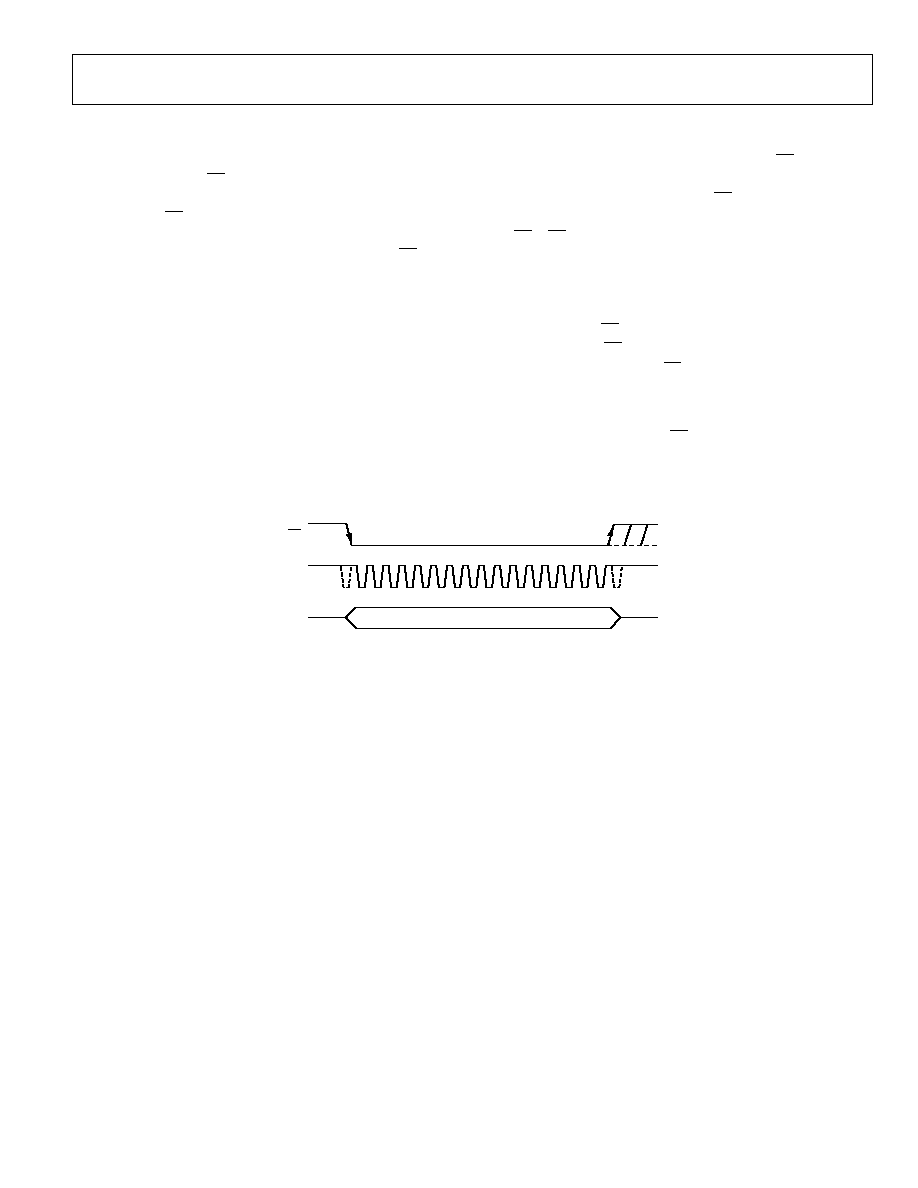
AD7940
Rev. 0 | Page 13 of 20
MODES OF OPERATION
The mode of operation of the AD7940 is selected by controlling
the (logic) state of the CS signal during a conversion. There are
two possible modes of operation, normal and power-down. The
point at which CS is pulled high after the conversion has been
initiated will determine whether or not the AD7940 will enter
power-down mode. Similarly, if already in power-down, CS can
control whether the device will return to normal operation or
remain in power-down. These modes of operation are designed
to provide flexible power management options. These options
can optimize the power dissipation/throughput rate ratio for
differing application requirements.
NORMAL MODE
This mode provides the fastest throughput rate performance
because the user does not have to worry about the power-up
times with the AD7940 remaining fully powered all the time.
Figure 16 shows the general diagram of the operation of the
AD7940 in this mode.
The conversion is initiated on the falling edge of CS as
described in the Serial Interface section. To ensure that the part
remains fully powered up at all times, CS must remain low until
at least 10 SCLK falling edges have elapsed after the falling edge
of CS. If CS is brought high any time after the 10th SCLK falling
edge, but before the 16th SCLK falling edge, the part will remain
powered up, but the conversion will be terminated and SDATA
will go back into three-state. At least 16 serial clock cycles are
required to complete the conversion and access the complete
conversion result. CS may idle high until the next conversion or
may idle low until CS returns high sometime prior to the next
conversion, effectively idling CS low.
Once a data transfer is complete (SDATA has returned to three-
state), another conversion can be initiated after the quiet time,
t
QUIET
, has elapsed by bringing CS low again.
03305-0-009
1
12
1 LEADING ZERO + CONVERSION RESULT
CS
SCLK
16
SDATA
Figure 16. Normal Mode Operation
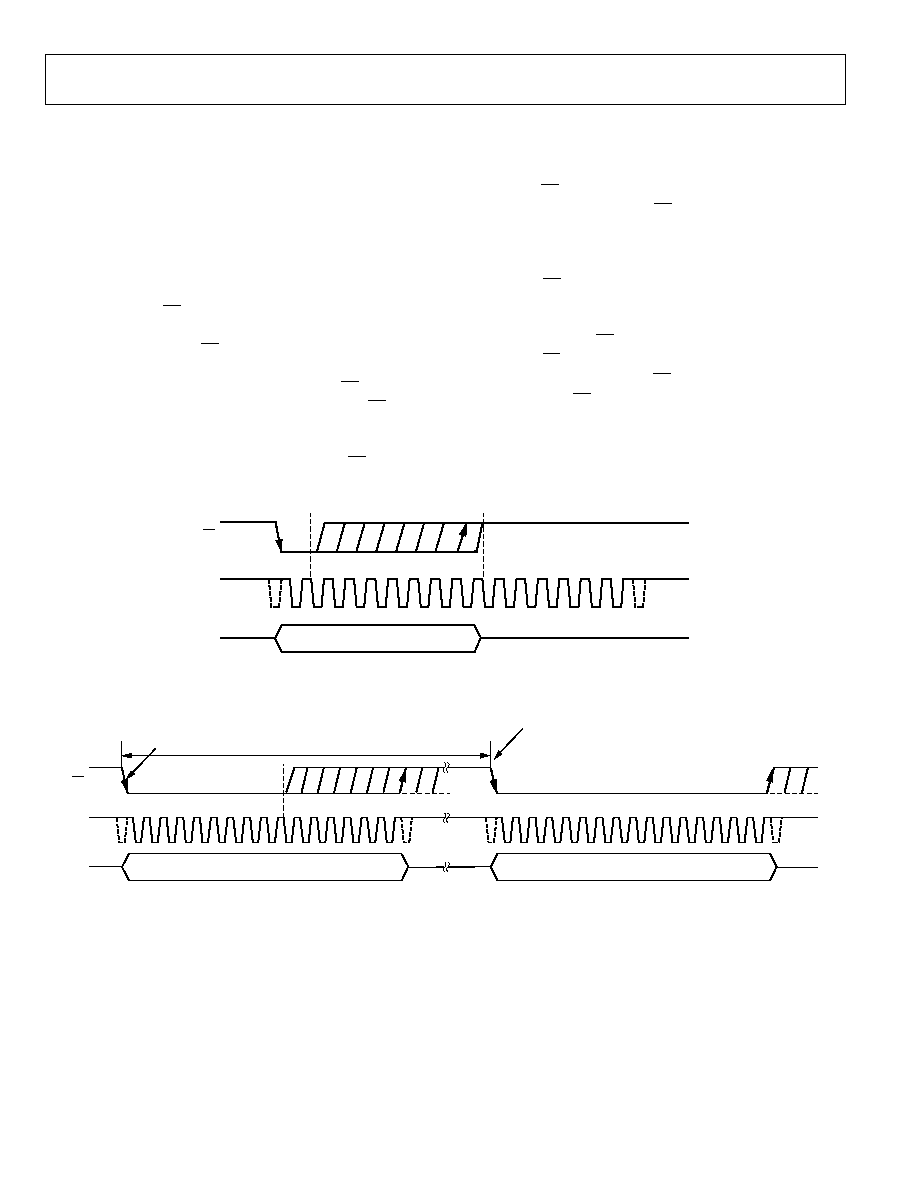
AD7940
Rev. 0 | Page 14 of 20
POWER-DOWN MODE
This mode is intended for use in applications where slower
throughput rates are required. Either the ADC is powered down
between each conversion, or a series of conversions may be
performed at a high throughput rate, and then the ADC is pow-
ered down for a relatively long duration between these bursts of
several conversions. When the AD7940 is in power-down, all
analog circuitry is powered down.
To enter power-down, the conversion process must be inter-
rupted by bringing CS high anywhere after the second falling
edge of SCLK and before the 10th falling edge of SCLK as
shown in Figure 17. Once CS has been brought high in this
window of SCLKs, the part will enter power-down, the
conversion that was initiated by the falling edge of CS will be
terminated, and SDATA will go back into three-state. If CS is
brought high before the second SCLK falling edge, the part will
remain in normal mode and will not power down. This will
avoid accidental power-down due to glitches on the CS line.
In order to exit this mode of operation and power up the
AD7940 again, a dummy conversion is performed. On the fal-
ling edge of CS, the device will begin to power up and will
continue to power up as long as CS is held low until after the
falling edge of the 10th SCLK. The device will be fully powered
up once at least 16 SCLKs (or approximately 6 µs) have elapsed
and valid data will result from the next conversion as shown in
Figure 18. If CS is brought high before the 10th falling edge of
SCLK, regardless of the SCLK frequency, the AD7940 will go
back into power-down again. This avoids accidental power-up
due to glitches on the CS line or an inadvertent burst of 8 SCLK
cycles while CS is low. So although the device may begin to
power-up on the falling edge of CS, it will power down again on
the rising edge of CS as long as it occurs before the 10th SCLK
falling edge.
03305-0-010
SCLK
SDATA
1
2
10
16
THREE-STATE
CS
Figure 17. Entering Power-Down Mode
03305-0-011
1
10
16
1
16
SDATA
SCLK
CS
INVALID DATA
VALID DATA
THE PART IS FULLY POWERED
UP WITH V
IN
FULLY ACQUIRED
THE PART BEGINS
TO POWER UP
t
POWER UP
Figure 18. Exiting Power-Down Mode
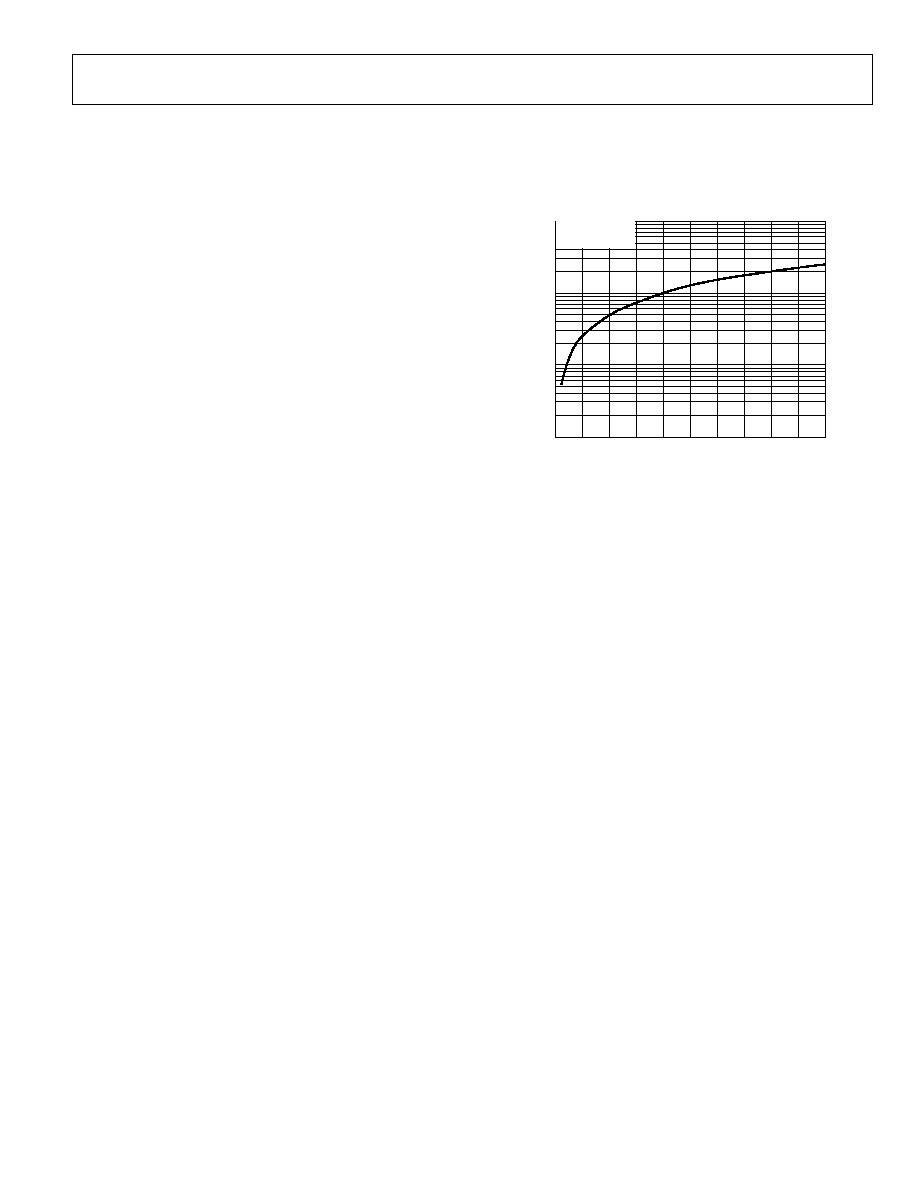
AD7940
Rev. 0 | Page 15 of 20
POWER VS. THROUGHPUT RATE
By using the power-down mode on the AD7940 when not
converting, the average power consumption of the ADC
decreases at lower throughput rates. Figure 19 shows how as the
throughput rate is reduced, the part remains in its shutdown
state longer, and the average power consumption over time
drops accordingly.
For example, if the AD7940 is operated in a continuous sam-
pling mode, with a throughput rate of 10 kSPS and an SCLK of
2.5 MHz (V
DD
= 3.6 V), and the device is placed in power-down
mode between conversions, the power consumption is calcu-
lated as follows. The maximum power dissipation during nor-
mal operation is 6.84 mW (V
DD
= 3.6 V). If the power-up time
from power-down is 1 µs, and the remaining conversion time is
6.4 µs, (using a 16 SCLK transfer), then the AD7940 can be said
to dissipate 6.84 mW for 7.4 µs during each conversion cycle.
With a throughput rate of 10 kSPS, the cycle time is 100 µs. For
the remainder of the conversion cycle, 92.6 µs, the part remains
in power-down mode. The AD7940 can be said to dissipate
1.08 µW for the remaining 92.6 µs of the conversion cycle.
Therefore, with a throughput rate of 10 kSPS, the average power
dissipated during each cycle is
(7.4/100) ◊ (6.84 mW) + (92.6/100) ◊ (1.08 µW) = 0.51 mW
Figure 19 shows the power dissipation versus the throughput
rate when using the power-down mode with 3.6 V supplies and
a 2.5 MHz SCLK.
03305-0-012
P
O
WE
R (mW)
0.01
0
5
10
15
20
25
THROUGHPUT (kSPS)
30
35
40
45
50
0.1
1
10
V
DD
= 3.6V
F
SCLK
= 2.5MHz
Figure 19. Power vs. Throughput Using Power-Down Mode at 3.6 V

AD7940
Rev. 0 | Page 16 of 20
SERIAL INTERFACE
Figure 20 shows the detailed timing diagram for serial interfac-
ing to the AD7940. The serial clock provides the conversion
clock and also controls the transfer of information from the
AD7940 during conversion.
The CS signal initiates the data transfer and conversion process.
The falling edge of CS puts the track-and-hold into hold mode,
takes the bus out of three-state, and samples the analog input.
The conversion is also initiated at this point and will require at
least 16 SCLK cycles to complete. Once 15 SCLK falling edges
have elapsed, the track-and-hold will go back into track mode
on the next SCLK rising edge as shown in Figure 20 at Point B.
On the 16th SCLK falling edge, the SDATA line will go back
into three-state. If the rising edge of CS occurs before 16 SCLKs
have elapsed, the conversion will be terminated and the SDATA
line will go back into three-state; otherwise SDATA returns to
three-state on the 16th SCLK falling edge as shown in Figure 20.
Sixteen serial clock cycles are required to perform the conver-
sion process and to access data from the AD7940. CS going low
provides the first leading zero to be read in by the microcontroller
or DSP. The remaining data is then clocked out by subsequent
SCLK falling edges beginning with the second leading zero, thus
the first falling clock edge on the serial clock has the first leading
zero provided and also clocks out the second leading zero. The
data transfer will consist of two leading zeros followed by the 14
bits of data. The final bit in the data transfer is valid on the 16th
falling edge, having been clocked out on the previous (15th)
falling edge.
It is also possible to take valid data on each SCLK rising edge
rather than falling edge, since the SCLK cycle time is long
enough to ensure the data is ready on the rising edge of SCLK.
However, the first leading zero will still be driven by the CS
falling edge, and so it can be taken only on the first SCLK falling
edge. It may be ignored, and the first rising edge of SCLK after
the CS falling edge would have the second leading zero pro-
vided and the 15th rising SCLK edge would have DB0 provided.
This method may not work with most microcontrollers/DSPs, but
could possibly be used with FPGAs and ASICs.
03305-0-013
t
4
t
CONVERT
2 LEADING ZEROS
3-STATE
3-STATE
B
SCLK
1
2
3
4
5
13
14
15
16
SDATA
0
ZERO
DB13
DB12
DB11
DB10
DB2
DB1
DB0
CS
t
2
t
3
t
6
t
7
t
5
t
8
t
QUIET
Figure 20. AD7940 Serial Interface Timing Diagram
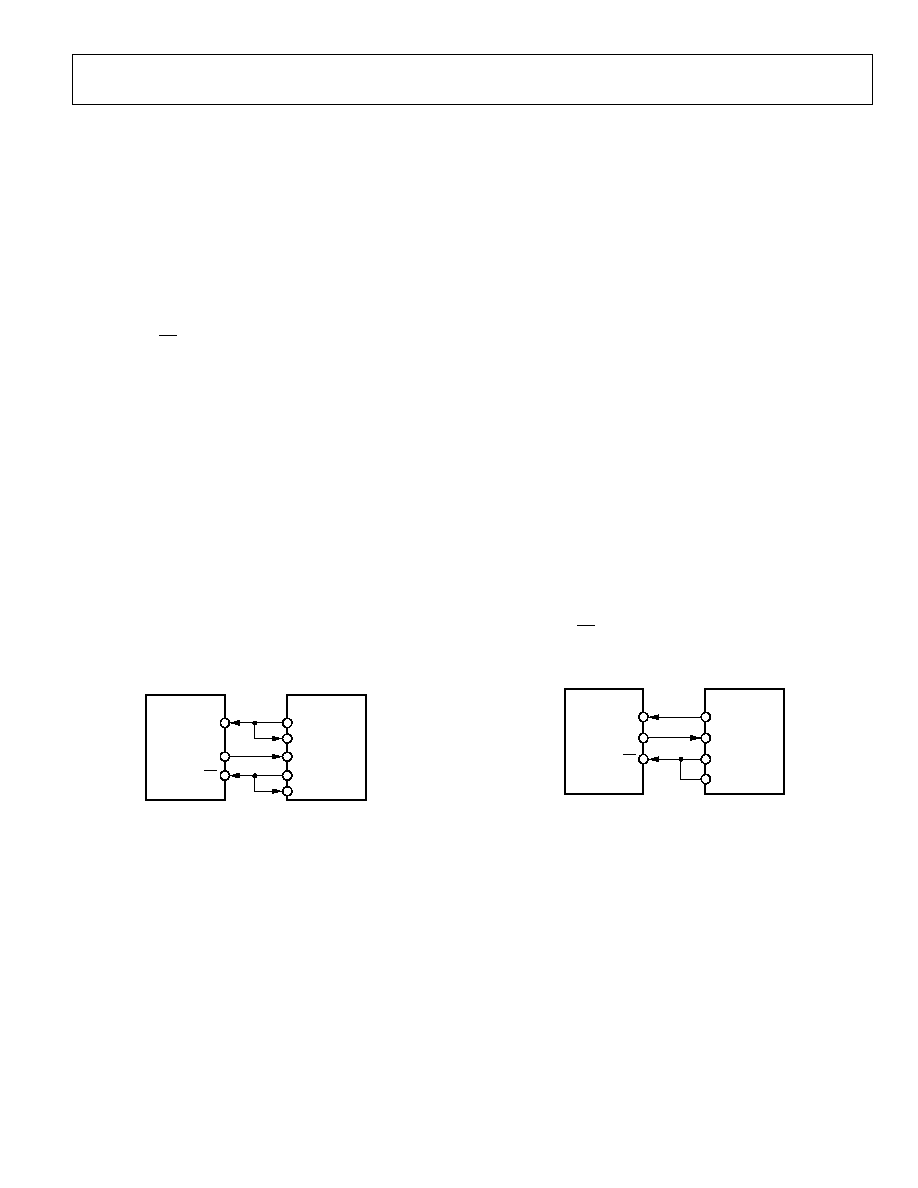
AD7940
Rev. 0 | Page 17 of 20
MICROPROCESSOR INTERFACING
The serial interface on the AD7940 allows the part to be directly
connected to a range of many different microprocessors. This
section explains how to interface the AD7940 with some of the
more common microcontroller and DSP serial interface
protocols.
AD7940 TO TMS320C541
The serial interface on the TMS320C541 uses a continuous
serial clock and frame synchronization signals to synchronize
the data transfer operations with peripheral devices such as the
AD7940. The CS input allows easy interfacing between the
TMS320C541 and the AD7940 with no glue logic required. The
serial port of the TMS320C541 is set up to operate in burst
mode with internal CLKX (TX serial clock) and FSX (TX frame
sync). The serial port control register (SPC) must have the
following setup:
FO = 0
FSM = 1
MCM = 1
TXM = 1
The format bit, FO, must be set to 1 to set the word length to
8 bits, in order to implement the power-down mode on the
AD7940. The connection diagram is shown in Figure 21. It
should be noted that for signal processing applications, it is
imperative that the frame synchronization signal from the
TMS320C541 provide equidistant sampling.
03305-0-014
AD7940*
TMS320C541*
*ADDITIONAL PINS OMITTED FOR CLARITY
SDATA
DR
CS
FSX
FSR
SCLK
CLKX
CLKR
Figure 21. Interfacing to the TMS320C541
AD7940 TO ADSP-218x
The ADSP-218x family of DSPs can be interfaced directly to the
AD7940 with no glue logic required. The SPORT control regis-
ter should be set up as follows:
TFSW = RFSW = 1, Alternate Framing
INVRFS = INVTFS = 1, Active Low Frame Signal
DTYPE = 00, Right Justify Data
SLEN = 1111, 16-Bit Data-Words
ISCLK = 1, Internal Serial Clock
TFSR = RFSR = 0, Frame First Word
IRFS = 0
ITFS = 1
To implement power-down mode, SLEN should be set to 0111
to issue an 8-bit SCLK burst.
The connection diagram is shown in Figure 22. The ADSP-218x
has the TFS and RFS of the SPORT tied together, with TFS set
as an output and RFS set as an input. The DSP operates in alter-
nate framing mode, and the SPORT control register is set up as
described. The frame synchronization signal generated on the
TFS is tied to CS, and, as with all signal processing applications,
equidistant sampling is necessary. In this example, the timer
interrupt is used to control the sampling rate of the ADC.
03305-0-015
SCLK
AD7940*
SDATA
CS
ADSP-218x*
SCLK
*ADDITIONAL PINS OMITTED FOR CLARITY
DR
RFS
TFS
Figure 22. Interfacing to the ADSP-218x
The timer register is loaded with a value that provides an
interrupt at the required sample interval. When an interrupt is
received, the values in the transmit autobuffer start to be trans-
mitted and TFS is generated. The TFS is used to control the
RFS and, therefore, the reading of data. The data is stored in the
receive autobuffer for processing or to be shifted later. The fre-
quency of the serial clock is set in the SCLKDIV register. When
the instruction to transmit with TFS is given, i.e., TX0 = AX0,
the state of the SCLK is checked. The DSP waits until the SCLK
has gone high, low, and high before transmission will start. If
the timer and SCLK values are chosen such that the instruction
to transmit occurs on or near the rising edge of SCLK, the data
may be transmitted, or it may wait until the next clock edge.
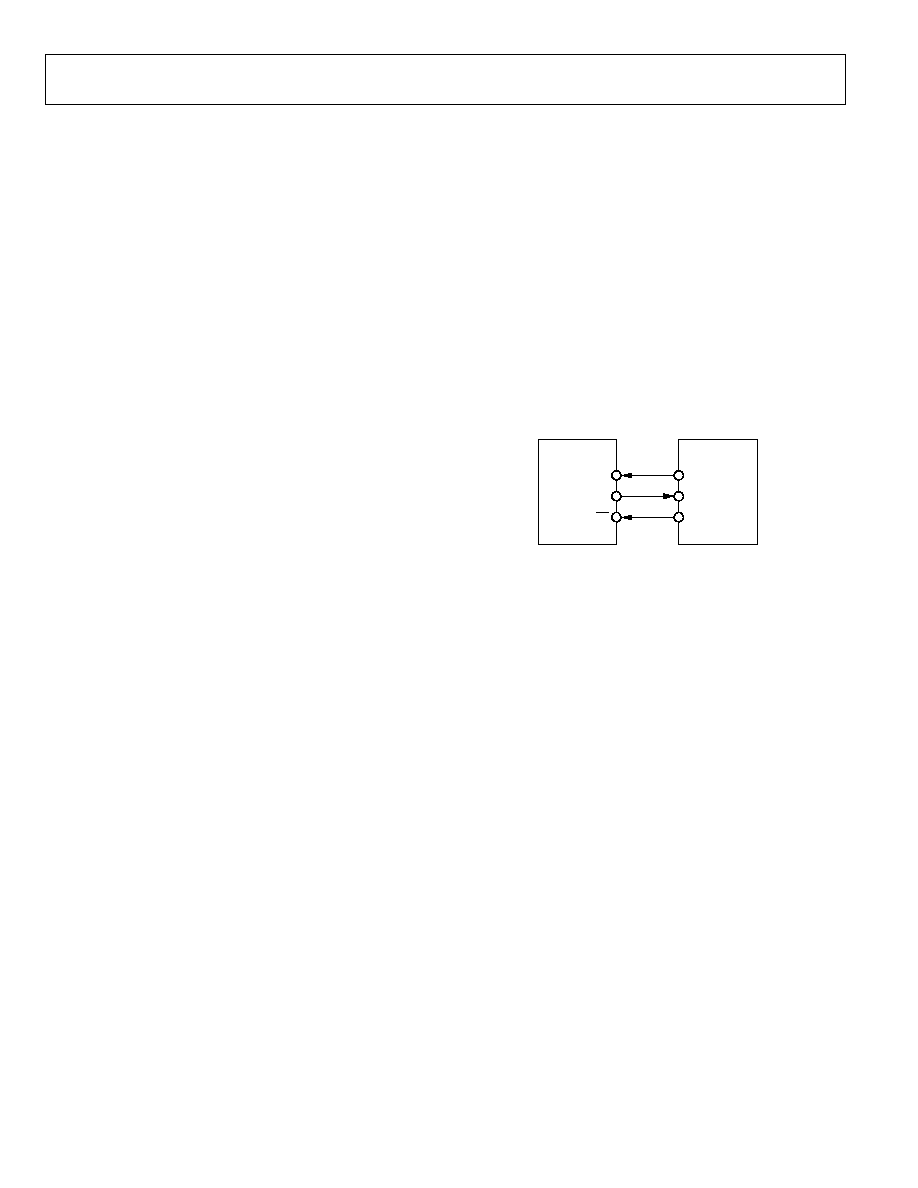
AD7940
Rev. 0 | Page 18 of 20
For example, if the ADSP-2189 had a 20 MHz crystal, such that
it had a master clock frequency of 40 MHz, the master cycle
time would be 25 ns. If the SCLKDIV register is loaded with the
value 7, then a SCLK of 2.5 MHz is obtained, and 16 master
clock periods will elapse for every 1 SCLK period. Depending
on the throughput rate selected, if the timer register was loaded
with the value 803 (803 + 1 = 804), then 50.25 SCLKs will occur
between interrupts and subsequently between transmit instruc-
tions. This situation will result in nonequidistant sampling since the
transmit instruction is occurring on a SCLK edge. If the number of
SCLKs between interrupts is a whole integer figure of N, then equi-
distant sampling will be implemented by the DSP.
AD7940 TO DSP563xx
The connection diagram in Figure 23 shows how the AD7940
can be connected to the ESSI (synchronous serial interface) of
the DSP-563xx family of DSPs from Motorola. Each ESSI (two
on board) is operated in synchronous mode (SYN bit in CRB =
1) with internally generated 1-bit clock period frame sync for
both Tx and Rx (Bits FSL1 = 0 and FSL0 = 0 in CRB). Normal
operation of the ESSI is selected by making MOD = 0 in the
CRB. Set the word length to 16 by setting bits WL1 = 1 and WL0
= 0 in CRA. The FSP bit in the CRB should be set to 1 so that
the frame sync is negative. It should be noted that for signal
processing applications, it is imperative that the frame synchro-
nization signal from the DSP-563xx provide equidistant
sampling.
In the example shown in Figure 23, the serial clock is taken from
the ESSI so the SCK0 pin must be set as an output, SCKD = 1.
03305-0-016
SCLK
AD7940*
DOUT
CS
DSP-563xx*
SCK
*ADDITIONAL PINS OMITTED FOR CLARITY
SRD
STD
Figure 23. Interfacing to the DSP-563xx

AD7940
Rev. 0 | Page 19 of 20
APPLICATION HINTS
GROUNDING AND LAYOUT
The printed circuit board that houses the AD7940 should be
designed such that the analog and digital sections are separated
and confined to certain areas of the board. This facilitates the
use of ground planes that can be separated easily. A minimum
etch technique is generally best for ground planes, since it gives
the best shielding. Digital and analog ground planes should be
joined at only one place. If the AD7940 is in a system where
multiple devices require an AGND to DGND connection, the
connection should still be made at one point only, a star ground
point that should be established as close as possible to the AD7940.
Avoid running digital lines under the device since these will
couple noise onto the die. The analog ground plane should be
allowed to run under the AD7940 to avoid noise coupling. The
power supply lines to the AD7940 should use as large a trace as
possible to provide low impedance paths and reduce the effects
of glitches on the power supply line. Fast switching signals, such
as clocks, should be shielded with digital ground to avoid radi-
ating noise to other sections of the board, and clock signals
should never be run near the analog inputs. Avoid crossover of
digital and analog signals. Traces on opposite sides of the board
should run at right angles to each other, which will reduce the
effects of feedthrough through the board. A microstrip tech-
nique is by far the best but is not always possible with a double-
sided board. In this technique, the component side of the board
is dedicated to ground planes while the signals are placed on the
solder side.
Good decoupling is also very important. All analog supplies
should be decoupled with 10 µF tantalum in parallel with 0.1 µF
capacitors to AGND, as discussed in the Typical Connection
Diagram section. To achieve the best performance from these
decoupling components, the user should attempt to keep the
distance between the decoupling capacitors and the V
DD
and
GND pins to a minimum, with short track lengths connecting
the respective pins.
EVALUATING THE AD7940 PERFORMANCE
The recommended layout for the AD7940 is outlined in the
evaluation board for the AD7940. The evaluation board package
includes a fully assembled and tested evaluation board, docu-
mentation, and software for controlling the board from the PC
via the evaluation board controller. The evaluation board con-
troller can be used in conjunction with the AD7940 evaluation
board, as well as many other Analog Devices evaluation boards
ending in the CB designator, to demonstrate/evaluate the ac and
dc performance of the AD7940.
The software allows the user to perform ac (fast Fourier trans-
form) and dc (histogram of codes) tests on the AD7940. The
software and documentation are on a CD shipped with the
evaluation board.
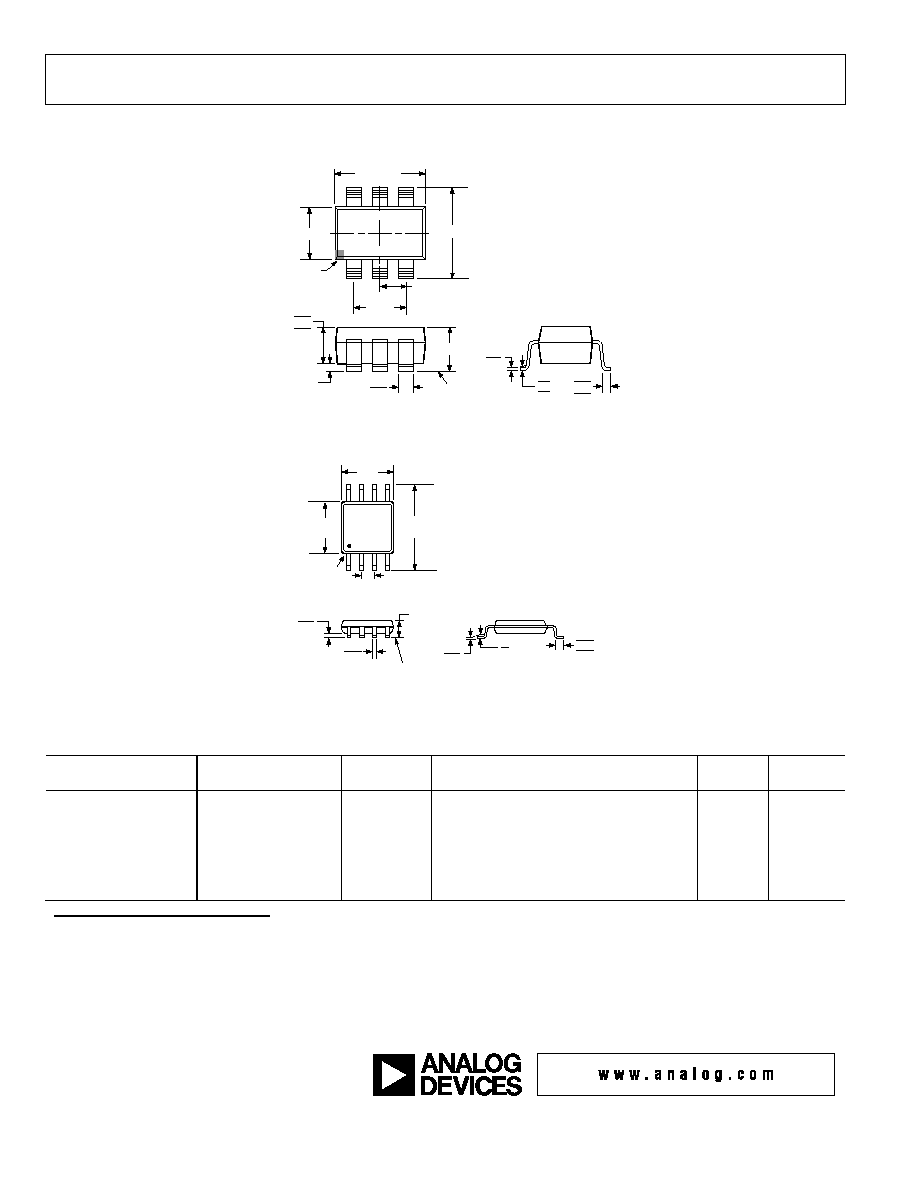
AD7940
Rev. 0 | Page 20 of 20
OUTLINE DIMENSIONS
1
3
4
5
2
6
2.90 BSC
1.60 BSC
2.80 BSC
1.90
BSC
0.95 BSC
0.22
0.08
10∞
4∞
0∞
0.50
0.30
0.15 MAX
1.30
1.15
0.90
SEATING
PLANE
1.45 MAX
0.60
0.45
0.30
PIN 1
INDICATOR
COMPLIANT TO JEDEC STANDARDS MO-178AB
Figure 24. 6-Lead Small Outline Transistor Package [SOT-23] (RJ-6). Dimensions shown in millimeters.
0.80
0.60
0.40
8∞
0∞
4
8
5
4.90
BSC
PIN 1
0.65 BSC
3.00
BSC
SEATING
PLANE
0.15
0.00
0.38
0.22
1.10 MAX
3.00
BSC
COPLANARITY
0.10
0.23
0.08
COMPLIANT TO JEDEC STANDARDS MO-187AA
Figure 25. 8-Lead Micro Small Outline Package [MSOP] (RM-8). Dimensions shown in millimeters.
ORDERING GUIDE
Models
Temperature Range
Linearity
Error (LSB)
1
Package
Description
Package
Option
Branding
AD7940BRJ-R2
-40∞C to +85∞C
14 Bits min
Small Outline Transistor Package (SOT-23)
RJ-6
CRB
AD7940BRJ-REEL7
-40∞C to +85∞C
14 Bits min
Small Outline Transistor Package (SOT-23)
RJ-6
CRB
AD7940BRM
-40∞C to +85∞C
14 Bits min
Micro Small Outline Package (MSOP)
RM-8
CRB
AD7940BRM-REEL7
-40∞C to +85∞C
14 Bits min
Micro Small Outline Package (MSOP)
RM-8
CRB
EVAL-AD7940CB
2
Evaluation
Board
EVAL-CONTROL BRD2
3
Controller
Board
1
Linearity error here refers to no missing codes.
2
This can be used as a standalone evaluation board or in conjunction with the Evaluation Controller Board for evaluation/demonstration purposes.
3
This board is a complete unit allowing a PC to control and communicate with all Analog Devices evaluation boards ending in the CB designators. To order a complete
evaluation kit, the particular ADC evaluation board needs to be ordered, e.g., EVAL-AD7940CB, the EVAL-CONTROL BRD2, and a 12 V ac transformer. See the Evaluation
Board application note for more information.
© 2004 Analog Devices, Inc. All rights reserved. Trademarks and
regis-
tered trademarks are the property of their respective owners.
D03305≠0≠6/04(0)



















